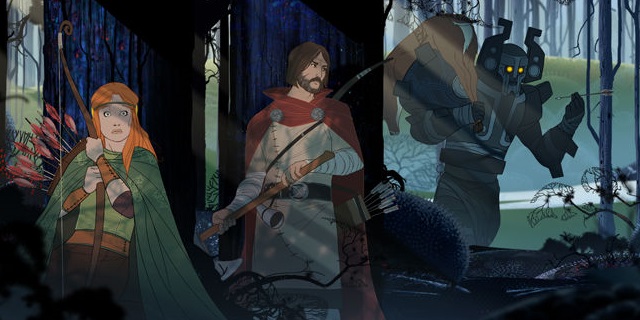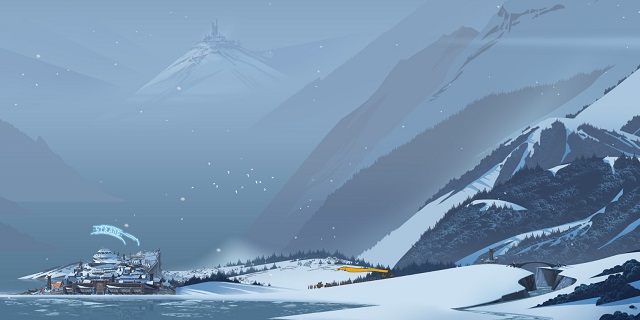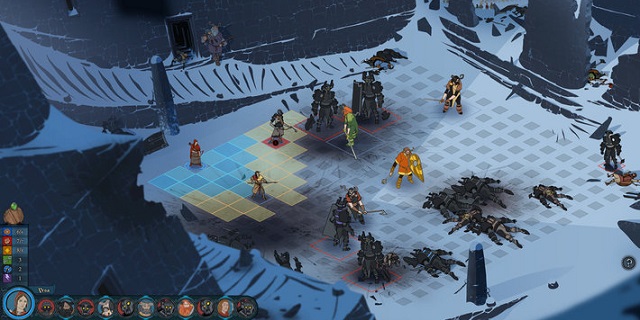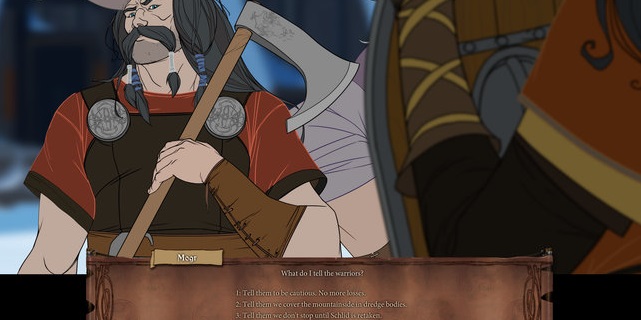
The Banner Saga is astoundingly beautiful. The art evokes classic animation like Don Bluth’s An American Tail and Disney’s Sleeping Beauty in a way that I’ve never seen in a game. The battlegrounds look amazing, and characters look alive in a way that can only be attained through hand-drawn animation. Final Fantasy Tactics looks nice, but The Banner Saga is simply breathtaking.
For all its beauty, though, the world of The Banner Saga is a hard one. The sun has stopped moving through the sky, the gods are dead, and the foe that killed them is back and straining the uneasy alliance between the humans and the giant, horned varl. Between battles, you’ll lead your caravan across the desolate snowy landscape, trying desperately to get to the next city to resupply before anybody starves to death or morale falls. Starving to death is obviously bad, as it means you’ll have fewer troops available. Low morale is also bad, as an improperly-motivated soldier, even if he’s a lumbering giant with a huge axe, is nowhere near as effective as a well-rested and happy one.
Moving across the landscape feels a lot like Oregon Trail. Your clansmen won’t develop dysentery or die of a broken arm, but random events will pop up, and you’ll make your choice regarding the clan’s best way forward. Like most things in The Banner Saga, there isn’t usually an obvious “best” way forward.

You have no idea if that group on the side of the road is hostile; all you’ve got is your gut and the knowledge that you can approach ready for a fight or with your hand extended in friendship. Either could go poorly for you. Approach a friendly camp with a snarl on your face and a spear ready to be thrown and you could take part in a fight neither side needs or wants. On the other hand, if you approach a group of bandits with nothing but a smile, you’ll be in for a fight at a disadvantage. The Banner Saga won’t telegraph which choice is the right one to make, and I like that. You never know the disposition of a person until you say “hello.”
When battle starts, and it will start no matter how much you try to avoid it, the world becomes a small grid-based battlefield. You’ll choose up to six heroes of varying classes to fight on your side, and then battle commences. Units are locked into classes, and progression is strictly linear. This is nice, as one shieldbanger, aside from level, is just like any other. But it’s a bit of a let-down after playing XCOM: Enemy Within (particularly with Training Roulette enabled), because, well, every shieldbanger is exactly the same. Consistency is nice, but customization is nicer.
As you battle, you’ll notice that the play areas are small. This is nice, because most units are slow and melee-only and walking across a giant battlefield is cumbersome. The field is so small, however, that every fight I took part in devolved into a giant slap-fight in the middle of the arena. Positioning does matter, particularly for special attacks, but try as I might, I was never able to separate the enemy into two groups or isolate a powerful unit to take him out early.

And then it clicked: I shouldn’t be trying to take out the enemy one unit at a time. I need to be weakening his entire force simultaneously. See, units have two primary statistics: armor and strength. Armor protects from damage as you’d expect, but strength describes both how had a unit can hit and how much life it has left. So when you your units all have five or more armor, that enemy unit with only one strength remaining isn’t an issue right now. He can stand there for a turn or two and plink away ineffectively while you whittle down the armor and strength of his comrades.
It’s an interesting change from other tactics games, in which a ranger with one measly hit point could win the bout by charging up his superpower from across the map. Here, that same archer is bloody, tired and can’t see straight enough to line up a good shot. You can still augment his movement and attack with willpower to make them more effective, though. Willpower is great, as it can prevent you from leaving a unit alive longer than necessary or get you into the action a turn sooner, but it has to be used sparingly.
Those giant brawls get crowded, though, and my biggest problem with The Banner Saga is a side effect of my favorite thing about it. The wonderful art prevents me from spinning the battlefield to get a better view of the action. Every warrior is animated for one view and one view only. This can make clicking on units problematic, and more than once I attacked a target accidentally or moved to a square where no attack was possible at all.

Throughout the game, both through battle and random events, you’ll earn renown. Renown is The Banner Saga’s universal currency. You’ll use it to promote your heroes and to buy supplies for the road. Do you strengthen your fighting force? Or do you make absolutely sure that nobody will starve before you make it to the next town? Without knowing how many days it will take to make it there, you can’t be sure. You’re certain to lose the next fight if you only ever buy food, and you’re certain to starve if you pump all of your renown into your fighters.
It’s stressful to manage a clan in the face of uncertainty, but like everything else in The Banner Saga, it works exceptionally well. Nothing is easy, and you never have enough information, supplies, or money. What you will have, though, is a great but short adventure that successfully blends The Oregon Trail, Tactics Ogre, and vikings into one entertaining and beautiful package.
Pros: Character attributes are both fresh and well-balanced, aesthetic is simply wonderful
Cons: Fixed battle perspective makes things difficult, units aren’t very customizable



















